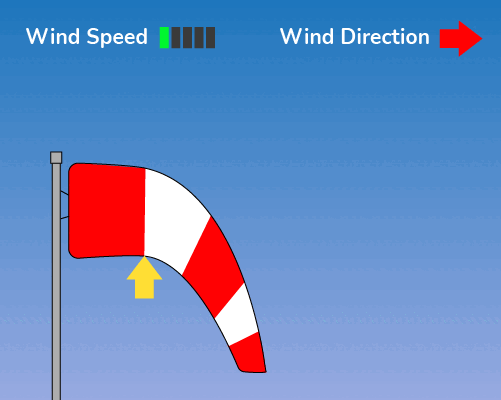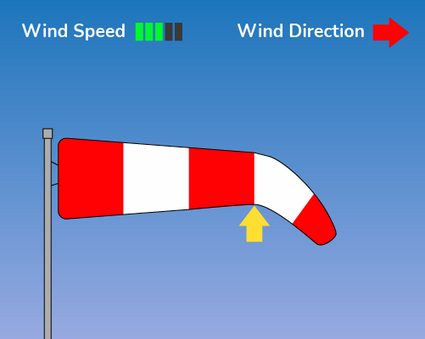Windsock Calculator
Every time you land at an airport, you see a windsock close to the runway: our windsock calculator will explain to you how to read this handy instrument; you will learn how to get, at a glance, some information about the roughness of the weather.
Keep reading this short article: here you will find:
- What are windsocks?
- How do I read a windsock?
- What is the relationship between a windsock and wind speed?
- How to use Omni's windsock calculator.
And much more: keep reading and safe landings!
What is a windsock?
Windsocks are tubular flag-like devices that, in a rather ingenuous way, show simultaneous indications of the wind's direction and intensity.
Windsocks are widespread worldwide: if humans are navigating in the air and at sea, knowing from which direction the wind blows is quite essential. At a glance, they can tell you from which direction to approach the runway or the harbor, for example. You can also read this information from wind vanes, but a windsock adds some hint of the intensity of the wind. If all the tube is straight up, you may want to reconsider your landing plan, even though the wind direction is just right!
Windsocks are not relegated to navigation. They are common in chemical plants, where they can suggest the best direction to go in case of a leak, and in sports, for example windsurfing, gliding, and so on!
Windsocks come in many shapes and colors, but one, in particular, lies in the collective imagination: those red-and-white striped truncated cones. Our windsock calculator will focus on them.
🙋 Most windsocks are truncated cones: Omni has a wonderful tool for this not-so-trivial shape, the truncated cone calculator! Try it 😉
Windsocks used in airports must be certified and follow rigid standards, usually decided by aviation organizations such as the FAA (Federal Aviation Administration). This way, the information would be understandable by any pilot coming in. What are a windsock's standards?
- Length (); and
- Diameter () of the large end.
Or:
- Length (); and
- Diameter () of the large end.
Windsocks at airports hang at () from the ground, on rigid masts. All the windsock calculations in this tool will refer to such devices: any different type or installation would require you to "calibrate" your windsock. How to do so? Use an approach similar to the one we explain in the linear regression calculator!
How do you read a windsock to calculate the wind speed?
No one expects windsocks to be sensible measuring instruments: you can't calculate the wind speed to the , but at most, you get a rough indication of the intensity of the wind, information about how interesting the landing will be.
To measure the airspeed, a windsock changes its angle. From a "relaxed" position, it gets progressively "straighter" until it reaches the horizontal position. More wind than that, and the windsock would simply disappear with the storm. Lousy information is still information, though, and remember that .
How to use our windsock calculator
Our windsock calculator is straightforward, but we are sure it will be a timesaver when you need it! You will only have to look at a certified windsock and count the rings or bands currently upright (in a horizontal position).

The animation above shows you what to expect for an increasing wind speed: the windsock is clearly rising. What is the relationship between the straightness of a windsock and the wind speed?
Yup: you are right; this is a very rough approximation! But it works and gives just enough information to allow for an estimation of the wind speed.
Now you know how to read a windsock. Let's check the possible situations you are going to find. Remember the animation before: here are the winds speeds the windsock would mark:
Winspeed | ||||
|---|---|---|---|---|
Indeed, the most challenging thing about reading windsocks is remembering the conversion between speed measurement units. If you need a hand, Omni is here with our speed converter!
To use our windsock calculator, input the number of "upright" segments of the windsock. We will print the resulting speed in knots, metric, and imperial: no more than that! Take the case below.

Three segments of the windsock are upright: . Use the formula above or the table to find the wind speed in knots:
After calculating the wind speed and direction, go to our wind chill calculator, and decide if the temperature is enough or if you prefer to go inside!
FAQs
How do I read a windsock?
To read a windsock, follow these easy steps:
-
Find a windsock, and align yourself to see it correctly.
-
Count the number of upright segments of the windsock,
n. -
To find the wind speed in knots, multiply
nby3:wind speed [knots] = n × 3 -
Remember that a windsock can't give you information on winds slower than
3 knotsor higher than15 knots.
What is the wind speed if a windsock is entirely extended?
A standard windsock is entirely extended for wind speeds higher or equal to 15 knots. Higher than that, the windsock will remain extended: even though we lack information on the wind speed, we still can use a windsock to understand the direction of the wind. In rough weather, this is fundamental information.
How does a windsock work?
A windsock works thanks to aerodynamics. Wind forced in the larger, gaping end of the windsock is compressed by the reduced cross-section of the cone. This compression corresponds to an increase in pressure inside the windsock. As a balloon, the windsock "inflates" and manages to expand against the atmosphere. Since the fabric defines the shape, increased compression makes the windsock progressively more upright as the length of the raised section grows.
Who invented the windsock?
Windsocks or similar devices have been known to humanity since the time of the Romans. However, only with the improvement of navigation techniques in the nineteenth century did the windsock start assuming the shape and purpose of the modern ones!
From then on, the technology of such devices didn't change much; however, better standardization and practice made them useful — if not fundamental — parts of navigation, both at sea and in the air.